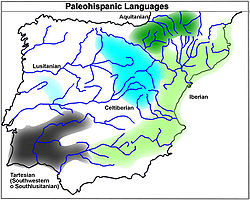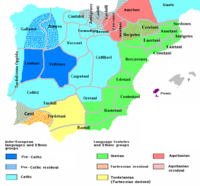
Paleohispanic languages
Encyclopedia


Pre-Roman peoples of the Iberian Peninsula
This is a list of the Pre-Roman peoples of the Iberian peninsula .-Non-Indo-European:*Aquitanians**Aquitani**Autrigones - some consider them Celtic .**Caristii - some consider them Celtic ....
, excluding languages of foreign colonies, such as Greek
Ancient Greek
Ancient Greek is the stage of the Greek language in the periods spanning the times c. 9th–6th centuries BC, , c. 5th–4th centuries BC , and the c. 3rd century BC – 6th century AD of ancient Greece and the ancient world; being predated in the 2nd millennium BC by Mycenaean Greek...
in Emporion
Empúries
Empúries , formerly known by its Spanish name Ampurias , was a town on the Mediterranean coast of the Catalan comarca of Alt Empordà in Catalonia, Spain. It was founded in 575 BC by Greek colonists from Phocaea with the name of Ἐμπόριον...
and Phoenician in Qart Hadast
Cartagena, Spain
Cartagena is a Spanish city and a major naval station located in the Region of Murcia, by the Mediterranean coast, south-eastern Spain. As of January 2011, it has a population of 218,210 inhabitants being the Region’s second largest municipality and the country’s 6th non-Province capital...
. After the Roman conquest of Hispania the Paleohispanic languages, with the exception of Proto-Basque
Proto-Basque language
Proto-Basque is a reconstructed predecessor of the Basque language, prior to the Roman conquests in the Western Pyrenees.-Background:...
, were replaced by Latin
Latin
Latin is an Italic language originally spoken in Latium and Ancient Rome. It, along with most European languages, is a descendant of the ancient Proto-Indo-European language. Although it is considered a dead language, a number of scholars and members of the Christian clergy speak it fluently, and...
, the ancestor of the modern Iberian Romance languages
Iberian Romance languages
The Iberian Romance languages or Ibero-Romance languages are the Romance languages that developed on the Iberian Peninsula, an area consisting primarily of Spain, Portugal, and Andorra....
.
Classification
Some of these languages were documented directly through inscriptions, mainly in Paleohispanic scriptsPaleohispanic scripts
The Paleohispanic scripts are the writing systems created in the Iberian peninsula before the Latin alphabet became the dominant script...
, that date for sure between the 5th century BC, maybe from the 7th century in the opinion of some researchers, until the end of the 1st century BC or the beginning of the 1st century AD.
- Iberian languageIberian languageThe Iberian language was the language of a people identified by Greek and Roman sources who lived in the eastern and southeastern regions of the Iberian peninsula. The ancient Iberians can be identified as a rather nebulous local culture between the 7th and 1st century BC...
- Celtiberian languageCeltiberian languageCeltiberian is an extinct Indo-European language of the Celtic branch spoken by the Celtiberians in an area of the Iberian Peninsula lyingbetween the headwaters of the Duero, Tajo, Júcar and Turia rivers and the Ebro river...
- Gallaecian languageGallaecian languageThe Northwestern Hispano-Celtic, Gallaecian or Gallaic, is classified as a Q-Celtic language under the P-Q system and was closely related to Celtiberian...
(also known as western Hispano-Celtic). - Tartessian languageTartessian languageThe Tartessian language is the extinct Paleohispanic language of inscriptions in the Southwestern script found in the southwest of the Iberian Peninsula: mainly in the south of Portugal , but also in Spain . There are 95 of these inscriptions with the longest having 82 readable signs...
(also known as the language of SW or South Lusitanian inscriptions)
Other Paleohispanic languages can only be identified indirectly through toponyms, anthroponyms or theonyms cited by Roman
Ancient Rome
Ancient Rome was a thriving civilization that grew on the Italian Peninsula as early as the 8th century BC. Located along the Mediterranean Sea and centered on the city of Rome, it expanded to one of the largest empires in the ancient world....
and Greek
Ancient Greece
Ancient Greece is a civilization belonging to a period of Greek history that lasted from the Archaic period of the 8th to 6th centuries BC to the end of antiquity. Immediately following this period was the beginning of the Early Middle Ages and the Byzantine era. Included in Ancient Greece is the...
sources.
- Aquitanian languageAquitanian languageThe Aquitanian language was spoken in ancient Aquitaine before the Roman conquest and, probably much later, until the Early Middle Ages....
- Sorothaptic languageSorothaptic languageSorothaptic is a name coined by Catalan scholar Joan Coromines for the hypothetical language of the presumably Indo-European, but pre-Celtic, Bronze Age people of the Urnfield culture in the Iberian Peninsula ....
(also known as Italoid) - Lusitanian languageLusitanian languageLusitanian was a paleohispanic language that apparently belonged to the Indo-European family. Its relationship to the Celtic languages of the Iberian Peninsula, either as a member, a cousin , or as a different branch of Indo-European, is debated. It is known from only five inscriptions, dated from...
Of these languages, Celtiberian, Lusitanian, presumably Sorothaptic and perhaps Tartessian were Indo-European languages
Indo-European languages
The Indo-European languages are a family of several hundred related languages and dialects, including most major current languages of Europe, the Iranian plateau, and South Asia and also historically predominant in Anatolia...
; Celtiberian was a Celtic language
Celtic languages
The Celtic languages are descended from Proto-Celtic, or "Common Celtic"; a branch of the greater Indo-European language family...
, and Lusitanian and (according to a new proposal) Tartessian might have been, but the hypothetical Sorothaptic was not. Tartessian and Iberian are generally considered unclassified language
Unclassified language
Unclassified languages are languages whose genetic affiliation has not been established by means of historical linguistics. If this state of affairs continues after significant study of the language and efforts to relate it to other languages, as in the case of Basque, it is termed a language...
s, while Aquitanian was a precursor of modern Basque
Basque language
Basque is the ancestral language of the Basque people, who inhabit the Basque Country, a region spanning an area in northeastern Spain and southwestern France. It is spoken by 25.7% of Basques in all territories...
.
See also
- Iberian languagesIberian languagesIberian languages is a generic term for the languages currently or formerly spoken in the Iberian Peninsula.- Pre-Roman languages :The following languages were spoken in the Iberian Peninsula before the Roman occupation and the spread of the Latin language.* Aquitanian * Proto-Basque* Tartessian*...
- Languages of SpainLanguages of SpainThe languages of Spain are the languages spoken or once spoken in Spain. Romance languages are the most widely spoken in Spain, of which Spanish is the country's official language...
- Languages of PortugalLanguages of PortugalThe languages of Portugal are the languages spoken or once spoken in the territory of the country of Portugal.-Modern:Portuguese is practically universal in Portugal, but there are some specificities.thumb|Portuguese dialects of Portugal...
- Hispano-Celtic languages
Further reading
- Correa, José Antonio (1994): «La lengua ibérica», Revista española de lingüística 24, 2, pp. 263–287.
- Jordán, Carlos (2004): Celtibérico, Zaragoza.
- Hoz, Javier de (1995): «Tartesio, fenicio y céltico, 25 años después», Tartessos 25 años después, pp. 591–607.
- Rodríguez Ramos, Jesús (2005): «Introducció a l'estudi de les inscripcions ibèriques», Revista de la Fundació Privada Catalana per l'Arqueologia ibèrica, 1, pp. 13–144.
- Untermann, Jürgen : Monumenta Linguarum Hispanicarum, Wiesbaden. (1975): I Die Münzlegenden. (1980): II Die iberischen Inschriften aus Sudfrankreicht. (1990): III Die iberischen Inschriften aus Spanien. (1997): IV Die tartessischen, keltiberischen und lusitanischen Inschriften.
- Velaza, Javier (1996): Epigrafía y lengua ibéricas, Barcelona.

